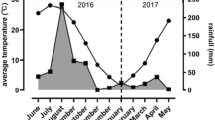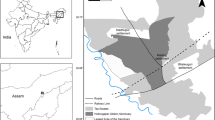Abstract
I studied the diet of a troop of Japanese macaques in the coniferous forest of Yakushima over one year via focal animal sampling. Fiber-rich foods constituted 45% of annual feeding time, and mature leaves constituted 38% of total feeding time. Feeding time on fruits and seeds was only 13% and 4%, respectively. Flowers and fungi contributed a considerable amount of annual feeding time: 15% and 14%, respectively. Their diet changed seasonally. They fed on more fruits and seeds in response to increased availability, and when these foods were not available, they ate mature leaves. When the temperature was low, they ate more herbs, possibly to save energy by not climbing trees and staying in sunny places. The results imply two dietary characteristics of the species that might relate to adaptations in temperate regions, where fruit is available during a limited season and fiber-rich foods are the only candidate of fallback food. They are capable of digesting a large amount of fiber-rich food, but at the same time they preferentially select high-quality fruits or seeds when they are available.
Similar content being viewed by others
Reference
Agetsuma, N. (1995). Dietary selection by Yakushima macaques (Macaca fuscata yakui): The influence of food availability and temperature. Int. J. Primatol. 16: 611-627.
Agetsuma, N. (2000). Influence of temperature on energy intake and food selection by macaques. Int. J. Primatol. 21: 103-111.
Agetsuma, N., and Nakagawa, N. (1998). Effects of habitat differences on feeding behaviors of Japanese monkeys: Comparison between Yakushima and Kinkazan. Primates 39: 275-289.
Ali, R. (1986). Feeding ecology of the bonnet macaque at the Mundanthurai Sanctuary, Tamilnadu. J. Bombay Nat. Hist. Soc. 83: 98-110.
Bercovitch, F. B., and Huffman, M. A. (1999). The macaques. In Dolhinow, P., and Fuentes, A. (eds.), The Nonhuman Primates, Mayfield Publishing, Mountain View, CA, pp. 77-85.
Caldecott, J. O. (1986). An Ecological and Behavioural Study of the Pig-Tailed Macaque, Contributions to Primatology Vol. 21, Karger, New York.
Chivers, D. J., and Hladik, C. M. (1980). Morphology of the gastrointestinal tract in primates: Comparisons with other mammals in relation to diet. J. Morphol. 166: 337-386.
Estrada, A., Juan-Solano, S., Martinez, T. O., and Coates-Estrada, R. (1999). Feeding and general activity patterns of a howler monkey (Alouatta palliata) troop living in a forest fragment at Los Tuxtlas, Mexico. Am. J. Primatol. 48: 167-183.
Furuichi, T., Hashimoto, C., and Tashiro, Y. (2001). Fruit availability and habitat use by chimpanzees in the Kalinzu Forest, Uganda: Examination of fallback foods. Int. J. Primatol. 22: 929-945.
Goldstein, S. J., and Richard, A. F. (1989). Ecology of rhesus macaques (Macaca mulatta) in northwest Pakistan. Int. J. Primatol. 10: 531-567.
Hanya, G., Noma, N., and Agetsuma, N. (2003). Altitudinal and seasonal variations in the diet of Japanese macaques in Yakushima. Primates 44: 51-59.
Hemmingway, C. A. (1998). Selectivity and variability in the diet of Milne-Edwards' sifakas (Propithecus diadema edwardsi): Implications for folivory and seed-eating. Int. J. Primatol. 19: 355-377.
Herrera, C. M. (1984). A study of avian frugivores, bird-dispersed plants, and their interaction in Mediterranean scrublands. Ecol. Monogr. 54: 1-23.
Herrera, C. M. (1985). Habitat-consumer interactions in frugivorous birds. In Cody, M. L. (ed.), Habitat Selection in Birds, Academic Press, Orlando, FL, pp. 341-365.
Hill, D. A. (1997). Seasonal variation in the feeding behavior and diet of Japanese macaques (Macaca fuscata yakui) in lowland forest of Yakushima. Am. J. Primatol. 43: 305-322.
Hladik, C. M. (1981). Diet and the evolution of feeding strategies among forest primates. In Harding, R. S. O., and Teleki, G. (eds.), Omnivorous Primates, Columbia University Press, New York, pp. 215-254.
Hladik, C. M., and Chivers, D. J. (1978). Concluding discussion: Ecological factors and specific behavioural patterns determining primate diet. In Chivers, D. J., and Herbert, J. (eds.), Recent Advances in Primatology, Vol. 1: Behaviour, Academic Press, London, pp. 433-444.
Kimura, K., and Yoda, K. (1984). Structure and regeneration process of evergreen conifers and broad-leaved trees in the Yaku-shima Wilderness Area, Yaku-Shima. In Nature Conservation Bureau, Environment Agency, Japan (ed.), Conservation Reports of the Yaku-Shima Wilderness Area, Kyushu, Japan, Environment Agency, Tokyo, pp. 399-436.
Kirkpatrick, R. C. (1999). Colobine diet and social organization. In Dolhinow, P., and Fuentes, A. (eds.), The Nonhuman Primates, Mayfield Publishing, Mountain View, CA, pp. 93-105.
Kirkpatrick, R. C., Long, Y. C., Zhong, T., and Xiao, L. (1998). Social organization and range use in the Yunnan snub-nosed monkey Rhinopithecus bieti. Int. J. Primatol. 19: 13-51.
Komiyama, A., Kato, S., and Teranishi, M. (2001). Differential overstory leaf flushing contributes to the formation of a patchy understory. J. For. Res. 6: 163-171.
Lambert, J. E. (1998). Primate digestion: Interactions among anatomy, physiology, and feeding ecology. Evol. Anthropol. 7: 8-20.
Lawes, M. J. (1991). Diet of samango monkeys (Cercopithecus mitis erythrarchus) in the Cape Vidal dune forest, South Africa. J. Zool. 224: 149-173.
Li, Y. (2001). The seasonal diet of the Sichuan snub-nosed monkey (Pygathrix roxellana) in Shennongjia Nature Reserve, China. Folia Primatol. 72: 40-43.
Newton, P. (1992). Feeding and ranging patterns of forest hanuman langurs (Presbytis entellus). Int. J. Primatol. 13: 245-285.
Nitta, I., and Ohsawa, M. (1997). Leaf dynamics and shoot phenology of eleven warm-temperate evergreen broad-leaved trees near their northern limit in central Japan. Plant Ecol. 130: 71-88.
O'Brien, T. G., and Kinnaird, M. F. (1997). Behavior, diet, and movements of the Sulawesi crested black macaques (Macaca nigra). Int. J. Primatol. 18: 321-351.
Porter, L. M. (2001). Dietary differences among sympatric Callitrichinae in northern Bolivia: Callimico goeldii, Saguinus fuscicollis and S. labiatus. Int. J. Primatol. 22: 961-992.
Sterling, E. J., Dierenfeld, E. S., Ashbourne, C. J., and Feistner, A. T. C. (1994). Dietary intake, food composition and nutrient intake in wild and captive populations of Daubentonia madagascarensis. Folia Primatol. 62: 115-124.
Strier, K. B. (1991). Diet in one group of wooly spider monkeys, or muriquis (Brachyteles arachnoides). Am. J. Primatol. 23: 113-126.
Su, H., and Lee, L. (2001). Food habits of Formosan rock macaques (Macaca cyclopis) in Jentse, northeastern Taiwan, assessed by faecal analysis and behavioral observation. Int. J. Primatol. 22: 359-377.
Therborgh, J. (1983). Five New World Primates, Princeton University Press, Princeton, NJ.
Thompson, J. N., and Wilson, M. F. (1979). Evolution of temperate fruit/bird interactions: Phenological strategies. Evolution 38: 973-982.
Ungar, P. S. (1995). Fruit preferences of four sympatric primate species at Ketambe, Northen Sumatra, Indonesia. Int. J. Primatol. 16: 221-245.
Wada, K. (1975). Ecology of wintering among Japanese monkeys in Shiga Heights and its adaptive significance. Physiol. Ecol. 16: 9-14.
Wheatley, B. P. (1980). Feeding and ranging of East Bornean Macaca fascicularis. In Lindburg, D. G. (ed.), The Macaques: Studies in Ecology, Behavior and Evolution, Van Nostrand Reinhold, New York, pp. 215-246.
Yakushima Forest Environment Conservation Center (2002). Annual Report of Yakushima Forest Conservation Center in 2000.
Yearger, C. P. (1996). Feeding ecology of the long-tailed macaque (Macaca fascicularis) in Kalimantan Tengah, Indonesia. Int. J. Primatol. 17: 51-62.
Author information
Authors and Affiliations
Rights and permissions
About this article
Cite this article
Hanya, G. Diet of a Japanese Macaque Troop in the Coniferous Forest of Yakushima. International Journal of Primatology 25, 55–71 (2004). https://doi.org/10.1023/B:IJOP.0000014645.78610.32
Issue Date:
DOI: https://doi.org/10.1023/B:IJOP.0000014645.78610.32




